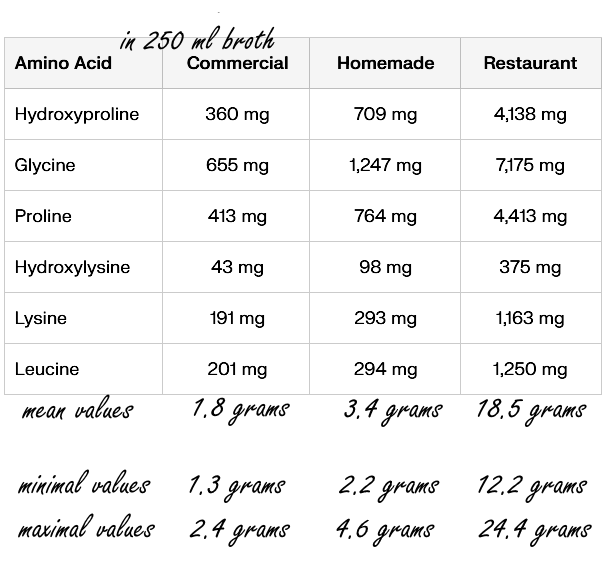Study
Well, not the study itself. You don't really hear the industry comment on the precise results of the research. You do, however, often hear the industry reproduce a conclusion from the Australian study. "If the intake of collagen precursors is proven to support the synthesis of new collagen in vivo, it's unlikely that bone broth can provide a consistently reliable source of key amino acids," the conclusion reads.
In other words, only supplements provide sufficient collagen, gelatin, or amino acids to improve the condition of your skin, joints, and bones.
The researchers drew this conclusion from analyses of various broths. They analyzed ready-made broths in the supermarket [Commercial], broths they made themselves using recipes online [Homemade], and broths made by professional chefs [Restaurant].
Results
Below you can see how many amino acids the researchers found in a 250 ml plate or cup of broth. Click on the table for a larger version.
However, professional chefs make broths that rival supplements in terms of amino acids. The main difference between the methods of professional chefs and those of amateurs is the cooking time. Professional chefs let their broths steep for up to 72 hours. This is considerably longer than the maximum cooking time of 24 hours found in conventional recipes.
More amino acids
Another way to increase the amino acid concentration is to leave the fat undisturbed. If the fat remains in the broth after cooking, the amino acid concentrations are higher than if the fat is skimmed off. Using beef bones also increases the amino acid concentration. Beef bones provide more amino acids than chicken bones.
Some recipes claim that adding vinegar during cooking increases the amino acid concentration in the broth, but the researchers didn't see this reflected in their results. As far as they could tell, vinegar had no effect on the amino acid concentration.
Hydrolyzed?
One advantage of supplements, however, is that they usually contain fully hydrolyzed collagen. When professional chefs make broth, a maximum of thirty percent of the proteins are hydrolyzed. The rest is in the broth as gelatin.





